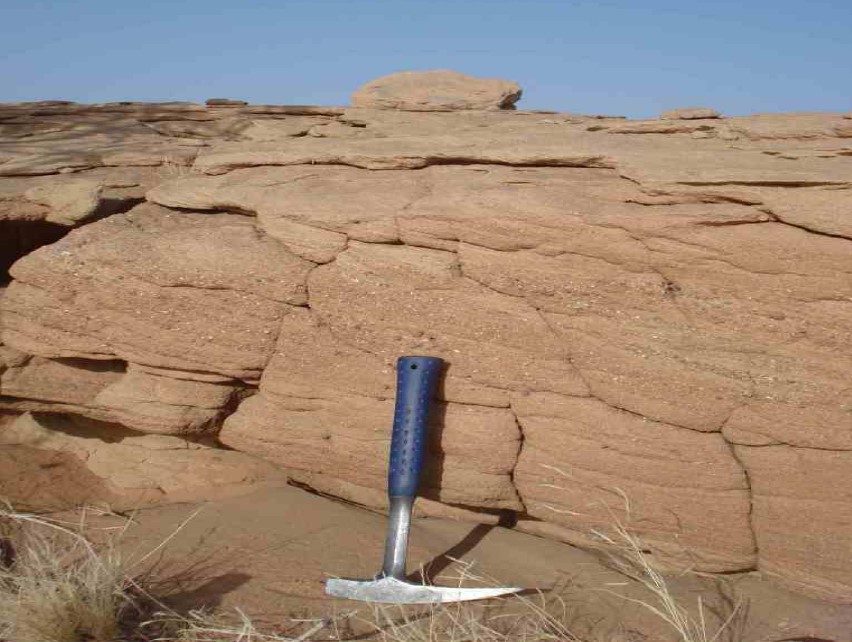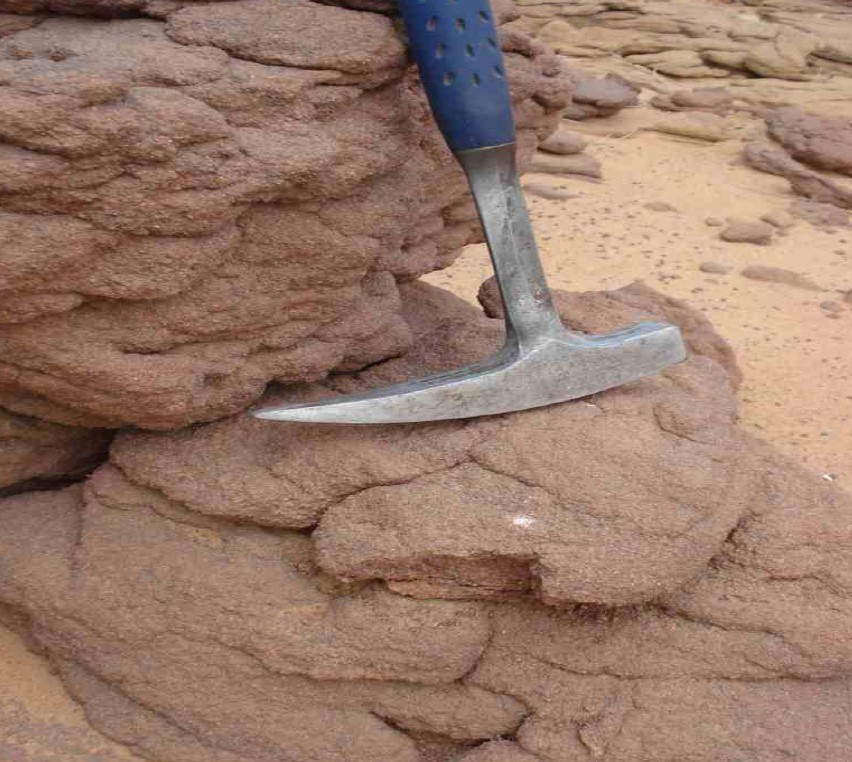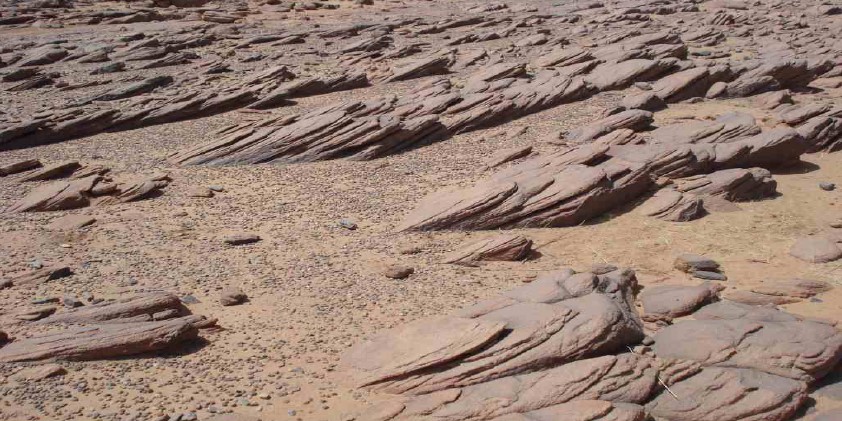Tchirezrine Fm
Type Locality and Naming
Joulia, 1951 & 1960. Western side of the Aïr. In the Agadez Gr, and in the Wagadi (lower part) and Dabla (upper part) Subgroups. Contains the Abinky Mbr,
References: Joulia, 1951, 1960; Valsardieu, 1971; Fabre et al., 1983; Moody, 1997 ; Abdoulaye et al., 2007 ; Billon & Patrier, 2019 ;
Synonym: Grès de Tchirezrine
Lithology and Thickness
Tchirezrine Fm consists of three members: Tchirezrine 1 (lower), Abinky (middle) and Tchirezrine 2 (upper) Members.
Tchirezrine 2 Mbr (upper): Formed locally of quartz gravels at the base showing faces of wind erosion. The rhythmic formation is dominated by feldspathic sandstones with fresh material, bound by a thin cement layer of oblique stratifications. Analcimolites and analcime argillites, in lenses or patches at the upper part of the sequences, are sometimes mineralized (Cu). Certain arkoses with analcime result from a mixture of fluvial sands and volcanic ash having undergone a diagenetic evolution (silicification, Cu, U mineralization) (Fabre et al., 1983). The sedimentary rocks of the Tchirezrine 2 Member consist of a succession of fine- to very coarse-grained sandstones (arkoses) that were deposited in a complex fluviatile system that can be described as a braided and meandering system. Analcimolite beds deposited in river floodplains associated with this fluviatile system occur intercalated between sandstones. The Member comprises very various and complex mineralogical assemblages, with the distinctive feature of presenting both tetravalent (UIV) and hexavalent (UVI) uranium mineralization, the second one being predominant. The stratiform type Imouraren deposit in the Tchirezrine 2 Member stands out also from the other Nigerien deposits by the abundant presence of analcime, especially with the analcimolite beds. The Member is also very porous; no reducing agents such as organic matter were observed (Billon et al., 2016 & 2019). 70 m thickness.
Abinky Mbr (middle): The Abinky Mbr’s analcimolites (Fig. 3) and red sandstones contain many fresh, unworn clastics and copper and uranium showings. Analcimolites would come from the diagenetic recrystallization of volcanic ash. In the lower passage zone, isogranular, feldspathic white sandstones contain analcime spherulites and carbonates. ~25 m thick. Abdoulaye, Konaté et al. (2007) distinguish 6 facies (top to bottom) (Fig. 2): •Facies 1: Massive yellow/ochre sandy analcimolite with brown stains
•Facies 2: Sandy analcimolite with yellow/ochre/greenish color lenses with some recrystallisation.
•Facies 3: Coarse sandstones with white, ochre, greenish analcimolite lenses
•Facies 4: A 5 m thick level of brownish/reddish analcimolite
•Facies 5: Coarse sandstones with angular grains. Rare layers of analcimolite lenses. Recrystallisation of silica is abundant in cavities.
•Facies 6: Massive sandstones with fine grains poorly cemented.
Tchirezrine 1 Mbr (lower): Conglomerates, grits, and sandstones. Arkosic, with scarce cement, medium to coarse, contains fine or micro-conglomeratic levels and lenses of analcime clay. The feldspars are angular. The analcime is in spherules. 50 m on average thickness.
[Figure 1: Cross-beds in coarse-grained to micro-conglomeratic sandstone of the Tchirezrine 1 Mbr (Source: CSA Global, 2017 & 2019)]
[Figure 2: Lithostratigraphic column of the Abinky Mbr (Source: Modified after Abdoulaye et al., 2007)]
[Figure 3: Massive analcimolite, Abinky Mbr (Source: CSA Global, 2017, 2019)]
[Figure 4: Cross-beds in the Tchirezrine 2 Mbr, DASA Graben (Source: CSA Global, 2017 &, 2019)]
Relationships and Distribution
Lower contact
Underlying unit is the Mousseden Fm or Teloua 3 Member of the Teloua Fm.
Upper contact
Overlying unit is the Assaouas Fm (when present) or the Irhazer Fm of the Irhazer Gr.
Regional extent
Iullemmeden Basin - Tim Mersoï Sub-basin; Western side of the Aïr massif.
GeoJSON
Fossils
In Abinky Mbr, Rootlet-bearing paleosols are common. In Tchirezrine 2 Mbr, Silicified wood.
Age
Depositional setting
Continental fluvio-lacustrine. In Tchirezrine 1 Mbr, Continental fluvio-lacustrine. The sedimentary information indicates a meandering flow to the north. In Abinky Mbr, the sedimentary information shows a meandering channel and underground flow (Fluvio-lacustrine sediments with red sandstones and analcimolite beds). In Tchirezrine 2 Mbr, Continental fluvio-lacustrine. Complex fluviatile system can be described as a braided and meandering system. River floodplain.
Additional Information
See also Agadez Gr, Wagadi and Dabla Subgroups. Valsardieu (1971) places Tchirezrine 1 [and Abinky] Mbr in the Wagadi Subgroup and Tchirezrine 2 Mbr in the Dabla Subgroup. As mentioned in the "Introduction", the Tchirezrine 1 Mbr should be renamed since it does not meet the stratigraphic guidelines of the International Commission on Stratigraphy (Web-09).



